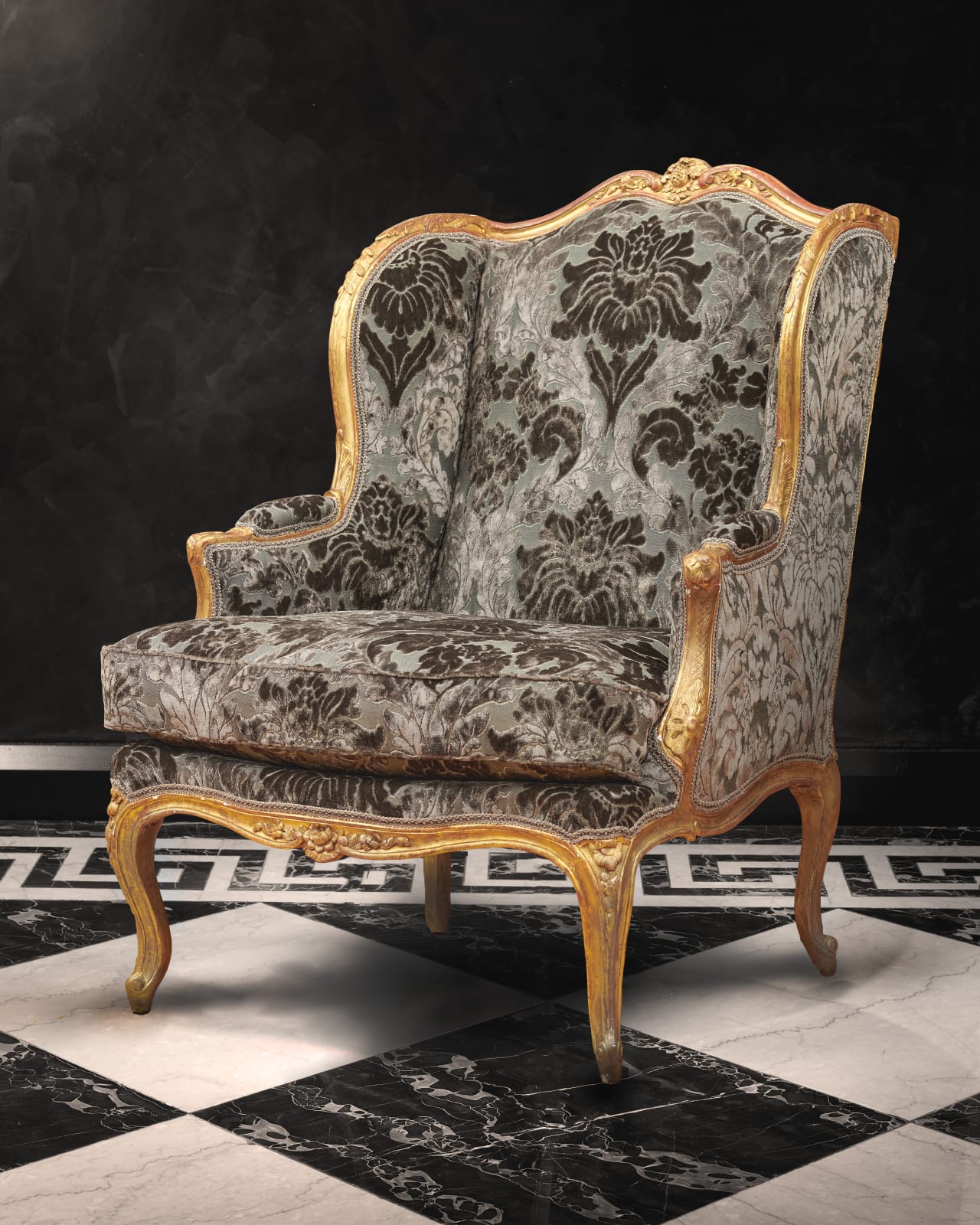Nicolas Heurtaut
Literature
F. J. B. Watson, “The Wrightsman Collection”, 1966, vol. I, p. 43, no. 30 A & B, illustrating one of a pair of comparable bergères à oreille by Tilliard (for whom Heurtaut once worked), in the Metropolitan Museum of Art, New York.
An extremely fine Louis XV carved and gilded beechwood bergère à oreille by Nicolas Heurtaut, stamped N. HEURTAUT, with a flat rectangular back and arched top, flanked either side by a deep curved wing that projects forward and rests on the arm, the carved beechwood frame with old gilding centred at the toprail by fruit, flowers and palm fronds with further fronds across the top of the projecting wings, the curved arm rests and serpentine-shaped seat rail carved with further floral and foliate sprays, on short cabriole legs each terminating in a scrolled foot, recently restored and newly upholstered in white calico
Paris, date circa 1755
Height 104 cm, width 76 cm, depth 65 cm.
One of the greatest maître sculpteurs of the Louis XV period, Nicolas Heurtaut worked both as a sculpteur and menuisier who supplied richly carved furnishings to royalty and nobility including the marquis de Villarceaux, the duc de Jaucourt and the duc de la Rochefoucault as well as the marchand-merciers and tapissiers. He was born in Paris and grew up on the Neume-de-Clarry, where his father Claude Heurtaut (d. 1749), worked as a sculpteur en sieges. Having begun as a sculpteur, working for a number of menuisiers such as Tilliard and Claude Sené, Heurtaut then entered the Académie de Saint-Luc in 1742. He was subsequently received as a maître in December 1755 and set up his own workshop in the rue de Bourbon-Villeneuve, where he specialised in the production of chairs as well as beds and occasionally consoles, adapting his style from the Rococo to the Transitional and then Neoclassical to reflect changing fashions.
As we see here, during the mid eighteenth century Heurtaut delighted in creating richly carved Rococo ornament to include seed pods, palm fronds volutes and floral garlands which may have been inspired by designs for seat-furniture by Juste-Aurèle Meissonnier from the 1730s or those drawn by Contant d’Ivry dating from the 1750s. A design attributed to Meissonnier in the Musée des Arts Décoratifs shows similar palm fronds as here framing the shoulders of the chair back, which was a motif that Heurtaut often used. Working as both a sculpteur and menuisier Heurtaut ornamented his own seat furniture and sub-contracted work to other craftsmen. Important commissions included a magnificent suite of eight carved giltwood fauteuils, a pair and a single canapé and a magnificent bed, which are believed to have been given by King Louis XV to his mistress, the Comtesse de Séran. Dating from circa 1755-60 and, as here, designed in the Rococo style, six of the fauteuils are now at Château de Versailles, as is the Comtesse de Séran’s lit à la Polonaise which is in the Grand Cabinet de la Dauphine.
Other important collections to own examples of Heurtaut’s work include the Musée du Louvre in Paris who own four large Louis XV fauteuils à la reine, a large canapé as well as six Transitional style fauteuils which were previously at Château de la Roche-Guyon. The Musées de la Voiture at Compiègne and also of Creil, each own a Louis XV chair by him as does the Museum of Fine Art in Boston. Added to them, the Paul Getty Museum in California houses one of his Louis XV bergères while a canapé, two marquises and four of his Louis XV fauteuils à la reine can be seen at the Frick Collection, New York. Further examples of his work can be seen in New York in the Wrightsman Collection at the Metropolitan Museum, which owns a set of four fauteuils à la reine as well as a pair of fauteuils en cabriolet, while a Transitional style bergère is now owned by the Hermitage Museum in St Petersburg.
